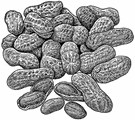Carver was born in 1860 in Diamond Grove, Missouri. His parents were slaves, and so was he. Prone to sickness, he was a frail child for most of his growing-up years. Because of this, he was not suited to heavy-duty work in the fields of his master's farm. Rather, George was sent to another town in Missouri, Neosho, to get an education. He proved so successful a student that he attended and then graduated from high school, in Kansas. He applied and was accepted to Highland University, even getting a scholarship for his good grades, but was rejected when the president of the university discovered that Carver was African-American. He was hungry for knowledge, and so Carver applied to and was accepted at Simpson College, in Indianola, Iowa. He later transferred to Iowa Agricultural College (now known as Iowa State University), He had from an early age been interested in plants (the study of botany), and he continued this study at the university greenhouse. He continued to study as well, earning his master's degree in agriculture in 1896. His greenhouse work included searching for cures for fungus diseases that ravaged cherry plants. The following year, opportunity knocked again, as Booker T. Washington, the famed African-American educator, invited Carver to come teach at the famed Tuskegee Institute, in Tuskegee, Alabama. Carver accepted and became director of agriculture. Among his many famous achievements at Tuskegee were these:
Not stopping there, Carver moved on to the sweet potato, which also grew in abundance. More than 115 products later, Carver was famous again, making flour, starch, and artificial rubber using the sweet potato. He turned next to the pecan, developing 75 products, found ways to use discarded corn stalks, and made paint and dye from clay. Many of his ideas were used by the U.S. Military during World War I. And his seemingly ceaseless imagination for using foods to make non-food items made his name a household word. He was invited to speak before Congress. Ford Motor Company founder Henry Ford invited He continued to work there until his death, on January 5, 1943. By that time, he had received numerous high-profile medals and awards and served on many boards and committees of the U.S. Department of Agriculture. A few months after Carver died, his birthplace became a national monument, the first dedicated to an African-American. Among the products created by Carver from various foods are the following:
Social Studies for Kids |

 where he made such an impression on his instructors that they offered a position right after he graduated. He was the first African-American on the faculty.
where he made such an impression on his instructors that they offered a position right after he graduated. He was the first African-American on the faculty. Peanuts, however, grew very quickly. Soon, the peanut crop threatened to overwhelm the farmers at Tuskegee. Carver came to the rescue by finding uses for the peanut. He ultimately invented more than 300 products that used the peanut in development, including cheese, milk, facial cream, ink, shampoo, and soap.
Peanuts, however, grew very quickly. Soon, the peanut crop threatened to overwhelm the farmers at Tuskegee. Carver came to the rescue by finding uses for the peanut. He ultimately invented more than 300 products that used the peanut in development, including cheese, milk, facial cream, ink, shampoo, and soap. Carver to his Dearborn, Mich., plant to discuss how to use goldenrod to make artificial rubber. Even the great Thomas Edison was impressed with Carver, inviting him to work at his Edison Laboratories for $100,000 a year. Carver refused, wanting to stay at Tuskegee.
Carver to his Dearborn, Mich., plant to discuss how to use goldenrod to make artificial rubber. Even the great Thomas Edison was impressed with Carver, inviting him to work at his Edison Laboratories for $100,000 a year. Carver refused, wanting to stay at Tuskegee.
